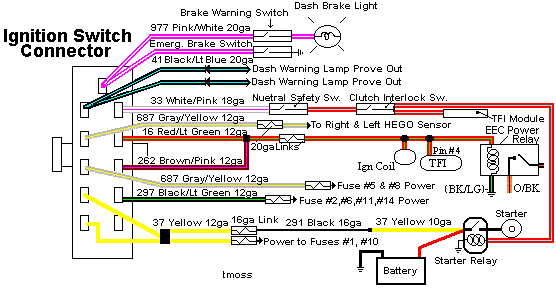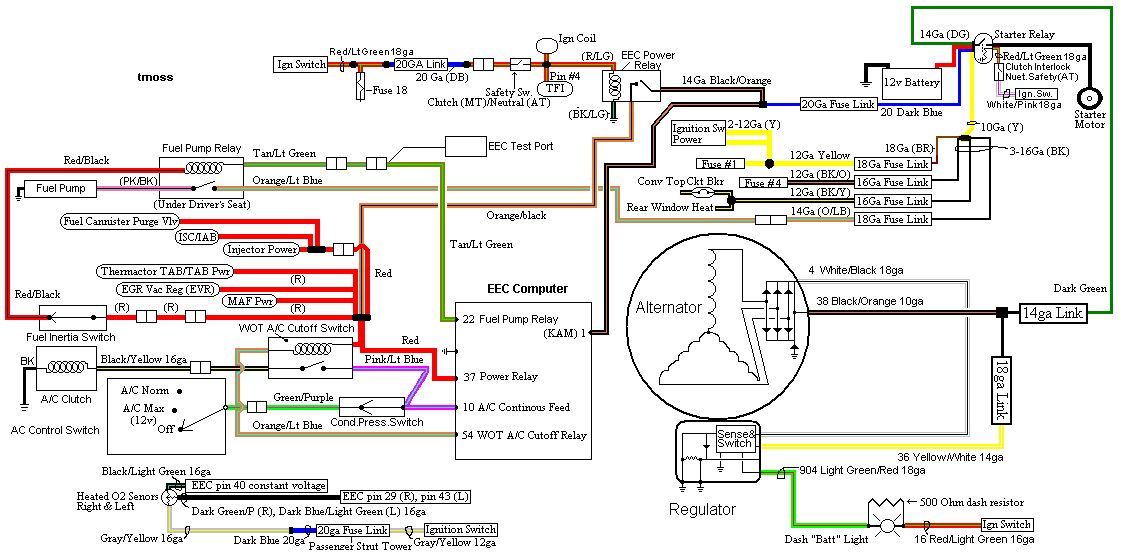- Mar 2, 2015
- 11
- 1
- 3
Posting on behalf of my roomie because he'll never get around to it, which means I'll be stuck driving him to/from work for the next eternity. Forgive my ignorance here. I'm not at all a Mustang guy so I'm probably using loads of hilariously incorrect n00b terms.

93 mustang 5.0. GT40P heads, 303(ish) cam. Roomie picked it up from a body guy who had the good sense to pay someone else to build the motor, but then the good sense flew out the window and he decided to do the electrical himself. Car ran and made more power than we deserve or is good for us when we got it, but it'd only do so for 15 minutes before dying. Leave it 15 minutes and it fires right back up and we're back on the highway at roughly 3.5 miles per gallerino (probably not THAT bad, but it's pretty terrible).
Typical TFI module overheat right? So we swapped in another TFI. Now it doesn't start. Another TFI, starts but same issue as before. Try another, no start. At this point we figure this cars fuel economy should be measured in miles per TFI.
We did track down a bunch of stupidity in the engine harness, and fixed it (sensors with the wires going to the wrong pins on the ECU, etc), but never got the TFI figured out. Tried a few different distributors, a few more TFI's, issue persists. Then we somehow flooded a few cylinders with fuel and petrolocked it. Thought we'd blown out some rings so parked it and put our efforts into the truck instead (LS / SAS 1500).
But, truck got hit with a VI and is now off the road and we need the Mustank back on the road.
I jumped into it the other night and noticed that with ignition off for about 20 minutes, the coil was hot enough to burn my hand. Unplugged the ground signal and checked it for continuity to ground. No continuity, but if I check for voltage to batt+, I do see 12V. How do I see 12V to battery, but no continuity to ground? Magnets. I'm sure magnets must be involved. Miracles all around.
So anyhow, here's where we're at now.
If we turn the ignition on, and swipe the coil ground signal across the coil signal pin, it sparks. Turn ignition off, it keeps sparking. Disconnect the TFI module from the harness, and the sparking stops. Plug it back in, and all is good. No sparks, no voltage, and no continuity. Turn ignition back on and then off, and we get a voltage path to the coil ground again until the TFI gets unplugged.
If however, we disconnect the TFI from the distributor and try the same trick, no ground path. Issue only happens when the TFI is plugged into the distributor (PIP connector).
My thought is that the PIP is somehow getting stuck in a position somehow, that tells the TFI we're always in firing position., This makes a lot of sense, because it explains why the cylinders flooded with fuel a few months back, despite the car not being turned on. It was leaving an injector or two wide open, and every time we cycled the ignition during testing, the fuel pump would kick on and spray fuel in.
I've done way more reading on this engine than I ever wanted to. One thing I find consistently though, is that the PIP, dizzy, TFI, and coil are ALWAYS causing problems for everyone, and that bad/flaky grounds are often the culprit, and finally, that the mustang guys know the 5.0 like the back of their hand.
So, who's got the "you stupid ing n00b, it's so simple!" answer for me? I'm loosing my mind trying to figure out the electrics in this thing. Newer GM motors make sense to me. Ford, not so much. Every time I check continuity on a ground, I get unexpected resistance, and usually find out it's supposed to be like that. How are you supposed to find shorts? I'm lost. HALP!
ing n00b, it's so simple!" answer for me? I'm loosing my mind trying to figure out the electrics in this thing. Newer GM motors make sense to me. Ford, not so much. Every time I check continuity on a ground, I get unexpected resistance, and usually find out it's supposed to be like that. How are you supposed to find shorts? I'm lost. HALP!

93 mustang 5.0. GT40P heads, 303(ish) cam. Roomie picked it up from a body guy who had the good sense to pay someone else to build the motor, but then the good sense flew out the window and he decided to do the electrical himself. Car ran and made more power than we deserve or is good for us when we got it, but it'd only do so for 15 minutes before dying. Leave it 15 minutes and it fires right back up and we're back on the highway at roughly 3.5 miles per gallerino (probably not THAT bad, but it's pretty terrible).
Typical TFI module overheat right? So we swapped in another TFI. Now it doesn't start. Another TFI, starts but same issue as before. Try another, no start. At this point we figure this cars fuel economy should be measured in miles per TFI.
We did track down a bunch of stupidity in the engine harness, and fixed it (sensors with the wires going to the wrong pins on the ECU, etc), but never got the TFI figured out. Tried a few different distributors, a few more TFI's, issue persists. Then we somehow flooded a few cylinders with fuel and petrolocked it. Thought we'd blown out some rings so parked it and put our efforts into the truck instead (LS / SAS 1500).
But, truck got hit with a VI and is now off the road and we need the Mustank back on the road.
I jumped into it the other night and noticed that with ignition off for about 20 minutes, the coil was hot enough to burn my hand. Unplugged the ground signal and checked it for continuity to ground. No continuity, but if I check for voltage to batt+, I do see 12V. How do I see 12V to battery, but no continuity to ground? Magnets. I'm sure magnets must be involved. Miracles all around.
So anyhow, here's where we're at now.
If we turn the ignition on, and swipe the coil ground signal across the coil signal pin, it sparks. Turn ignition off, it keeps sparking. Disconnect the TFI module from the harness, and the sparking stops. Plug it back in, and all is good. No sparks, no voltage, and no continuity. Turn ignition back on and then off, and we get a voltage path to the coil ground again until the TFI gets unplugged.
If however, we disconnect the TFI from the distributor and try the same trick, no ground path. Issue only happens when the TFI is plugged into the distributor (PIP connector).
My thought is that the PIP is somehow getting stuck in a position somehow, that tells the TFI we're always in firing position., This makes a lot of sense, because it explains why the cylinders flooded with fuel a few months back, despite the car not being turned on. It was leaving an injector or two wide open, and every time we cycled the ignition during testing, the fuel pump would kick on and spray fuel in.
I've done way more reading on this engine than I ever wanted to. One thing I find consistently though, is that the PIP, dizzy, TFI, and coil are ALWAYS causing problems for everyone, and that bad/flaky grounds are often the culprit, and finally, that the mustang guys know the 5.0 like the back of their hand.
So, who's got the "you stupid
 ing n00b, it's so simple!" answer for me? I'm loosing my mind trying to figure out the electrics in this thing. Newer GM motors make sense to me. Ford, not so much. Every time I check continuity on a ground, I get unexpected resistance, and usually find out it's supposed to be like that. How are you supposed to find shorts? I'm lost. HALP!
ing n00b, it's so simple!" answer for me? I'm loosing my mind trying to figure out the electrics in this thing. Newer GM motors make sense to me. Ford, not so much. Every time I check continuity on a ground, I get unexpected resistance, and usually find out it's supposed to be like that. How are you supposed to find shorts? I'm lost. HALP!










 . IE: with ignition on, if we unplug and replug the TFI from the harness, fuel pump relay, and injectors trip, and sometimes the engine tries to crank for 1/2 a second. Seeing 5V on the ground wire at the TFI makes it real difficult to verify that it's actually ground. Same with TPS. We actually discovered the stray voltage (5V) coming out of the ECU pin 47 because we were trying to calibrate the TPS, but couldn't get the signal voltage low enough. Some times it'd read as low as 2V, while sometimes it'd show 7-8V. 5V reference was good, ground was ground, but that green wire was showing 5V, even after cutting the TPS off the wire entirely. Thus, that 5V is coming from the ECU.
. IE: with ignition on, if we unplug and replug the TFI from the harness, fuel pump relay, and injectors trip, and sometimes the engine tries to crank for 1/2 a second. Seeing 5V on the ground wire at the TFI makes it real difficult to verify that it's actually ground. Same with TPS. We actually discovered the stray voltage (5V) coming out of the ECU pin 47 because we were trying to calibrate the TPS, but couldn't get the signal voltage low enough. Some times it'd read as low as 2V, while sometimes it'd show 7-8V. 5V reference was good, ground was ground, but that green wire was showing 5V, even after cutting the TPS off the wire entirely. Thus, that 5V is coming from the ECU.